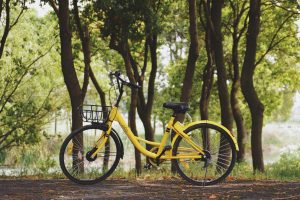Bicycle safety tips – how to stay safe on the road
- Michael
- Last Updated August 27, 2023
We are a reader supported site. We earn commissions when you buy through links on our site. Learn more.
When I first began cycling as a child, I knew the basic rules like wearing a helmet. Key things like the right bike size, comfortable shoes, and road signs were enough for me to get started.
But as you take on more advanced cycling trails, you have to adopt more bicycle safety tips. Here are five bicycle safety tips I’ve learned while biking through the years.
Tip 1: Pick the Right Bike
A big tip for bicycle safety is to have the right gear in the first place.
There are different types of bikes optimized to help you keep control on different terrains. Here are some of the most popular bicycle types:
- Road bikes: contain skinny tires ideal for smooth pavement.
- Touring bikes: can carry heavy loads, suitable for riding uphill areas.
- Mountain bikes: have straight bars to keep you upright and thick tires with shock absorbers.
- Hybrid bikes: combine road and mountain bike advantages.
Read More: Types Of Bikes – What Is The Best Type Of Bike For Me In 2023?
Bear in mind that hybrid bikes might be too heavy for street cycling and too thin for rocky terrains.
There are many more bicycle types you can find to modify to your needs.
I recommend you consider where you’ll realistically use the bike the most. Also, don’t underestimate how much a different bike can impact your performance.
For example, a study on tire treads shows that mountain bike tires with thick textures grip rocky roads well. However, they create too much friction on smooth pavement.
On the other hand, road bicycles have smooth tires that can slip on dirt terrains. So, take your time to select the right bike.
Tip 2: Keep a First Aid Kit
No matter how careful you are, accidents can happen. For example, I’ve narrowly avoided a tree branch falling while cycling before.
If you’re cycling in a city zone, it could be easy to find a pharmacy or health clinic if you get a scratch. But for trail biking, it’s crucial to keep a mini first aid kit for instant care.
A shortlist of things you can pack are:
- Tweezers.
- Bug bite cream.
- Antiseptic towelettes.
- Pressure bandages.
- Triangular bandages.
If a bug bites you, tweezers are useful to remove stingers. Plus, antiseptic towelettes and pressure bandages help soothe any cuts and scrapes. A triangular bandage is also essential to secure someone’s arm if they dislocate it.
I know this may sound like a lot of tools to carry. But some outlets offer compact cycling first aid kits fit for your primary needs.
Red Cross has a short guide on how to curate your first aid kit. You can also take additional outdoor bicycle safety notes from the National Park Service’s essentials list.
Finally, make sure you pack enough water for your journey. Studies show dehydration impairs your cycling ability, so take care of yourself.
Tip 3: Be Predictable
Aim to be predictable on both street cycling and terrain cycling. You can make it easier for other people to notice you by:
- Cycling in the same direction as traffic.
- Using your turn signals.
- Obeying street signs.
- Signaling pedestrians in your way.
You can ring your bike bell (if you have one) to alert people crowding a sidewalk to make space for you.
However, make sure you’re cycling at a safe speed in the first place. If the pedestrians still don’t move, you want to be able to halt your bike before a crash.
Don’t text or listen to music while you cycle. Having open ears for the road lets you listen to car beeps or any other potential warnings.
Also, avoid sidewalk cycling when you can. You’re more likely to run into pedestrians and fire hydrants on the sidewalk than on a smooth cycling lane.
Tip 4: Know Your Trail
It’s a good idea to familiarize yourself with a new terrain so you can anticipate any problems before they happen. Rocky areas, plants, and mountain dips are all features that will make you slow down on your trail.
Study a roadmap of a new trail before you go. You can also bring a friend to keep you safe if it’s your first mountain ride. Friends will help warn you of extra bumps on the road and can help you in the event of an injury.
As a bonus, give someone at home your cycling itinerary. That tool will help them find you if you need help but are in a no signal area.
Avoid soft or wet trails, be mindful of animals, and find out if there’s dangerous plant life on the terrain. Any other risks are manageable as long as you’re mindful to prevent and treat them.
What if your bike breaks on the trail? The answer is to stop cycling and walk beside it. You can also pack some basic tools and learn to handle beginner-level repairs on your own.
Tip 5: Wear the Right Gear
I know wearing a helmet is one of the most famous rules for bicycle safety. But it has a good reason. Wearing a helmet is 85-88% effective at mitigating brain injuries.
Other body armor like knee pads and elbow guards can also protect you from scuffs and bumps.
The colors you wear matter, too. As a general rule, fluorescent colors will make you safer during road cycling because they seem to ‘glow’ in the daylight.
In fact, a traditional yellow bicycle jacket reduces accident rates because it helps vehicles spot you easier.
Finally, it’s best to cycle in the daylight, so you see everything in your path. But if you ever need to cycle at night, purchase a bike light to guide your path and make you noticeable to cars.
Summary
I hope these tips make you feel like you have bicycle safety down packed.
Whatever you do, start slow. Don’t push yourself past the limits of your cycling level, and take care of your health. Proper sleep, eating, and hydration will help keep you energized while cycling. In turn, you’ll last longer on the bike and enjoy the ride more.

Michael
Hi, my name is Michael and I'm the chief editor of this website.
I've been riding all sorts of bikes for over a decade now and don't plan on stopping anytime soon.
Everyday, I learn new things and want to share my experiences with others.
Ready to join me on my journey?






